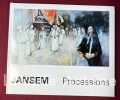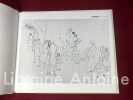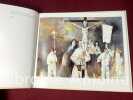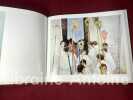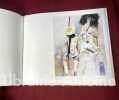JANSEM
Processions.
Paris Galerie Matignon 1986 In-8 oblong (h. 22 x 26 cm.) couverture cartonnée.
Reference : 4085
Très bon état. Libraire membre du S.L.A.M. (Syndicat national de la Librairie Ancienne et Moderne) et de la L.I.L.A. (Ligue Internationale de la Librairie Ancienne). N'hésitez pas à prendre contact par mail pour des photographies et des détails supplémentaires, pour des recherches ou des estimations de livres anciens et rares.
Bookseller's contact details
LIBRAIRIE ANTOINE
M. ALEXIS-RAPHAËL ANTOINE
39 bis rue Molitor
75016 Paris
France
01 40 71 91 57
Payment mode
Sale conditions
conditions du Syndicat de la Librairie Ancienne et Moderne
5 book(s) with the same title
La Maison-Dieu n° 43 - Les processions, Les processions dans la Bible par François Louvel, Sens humain de la procession par Paul Doncoeur, Note sur la sociologie des processions par I.H. Dalmais, Les diverses formes de procession dans la liturgie par A.G.
Editions du cerf. 3e trimestre 1955. In-12. Broché. Bon état, Couv. convenable, Dos satisfaisant, Intérieur frais. 175 pages.. . . . Classification Dewey : 200-RELIGION
Sommaire : Les processions, Les processions dans la Bible par François Louvel, Sens humain de la procession par Paul Doncoeur, Note sur la sociologie des processions par I.H. Dalmais, Les diverses formes de procession dans la liturgie par A.G. Martimort, Les chants de procession par Joseph Gelineau Classification Dewey : 200-RELIGION
Art Moves. The Material Culture of Processions in Renaissance Perugia
, Brepols - Harvey Miller, 2019 Hardback, iv + 323 pages, Size:220 x 280 mm, Illustrations:69 col., Language: English. ISBN 9781909400832.
Summary "Art Moves" reconstructs the appearance and conditions of use of processional artifacts, whether they were worn (uniforms and liveries), held by individuals, (maces, flags, and candles), or carried communally (canopy, reliquaries, banners, or statues). This is the first book on the material culture of processions as a performative, multi-media, apparatus. It investigates how objects were charged with meaning from medium and fabrication to market value to size and weight. Ritual settings gave them a symbolic force that was heightened through their mobility. In the public events studied here - religious and civic celebrations, elite funerals, papal entries, city-wide penance, and relic transfers - 'moving' [pun intended] objects became the meaningful vehicles of ritual efficacy, shaping ideology, group solidarity, and social cohesion. Despite the liturgical framework, processional paraphernalia foregrounded the laity, notably secular authorities and confraternities. Art Moves also raises the issue of conflict that material ephemera could invite or even spark. Renaissance Perugia, a middling-sized city, presents a wealth of textual, visual, and material evidence, not to mention its medieval and renaissance topography. In Perugia more than anywhere else perhaps, several banners played a key role in crisis processions, becoming cult objects revered into the nineteenth century. This study also revisits artistic representations of corteges, questioning the extent of their documentary value. The approach intertwines the disciplines of art history, social history, material culture, religious studies, and anthropology. This publication offers a new way of looking at the dynamics of urban processions while revivifying the sensory experience of public life in Italy, ca. 1350-1600. With a preface by Jean-Claude Schmitt.
Amateur photographer n° 3368 - Routes of the processions, Coronation route in pictures, Westminster abbey by K.W. Fitzgerald, Photographing processions by J.W. Philpot, Photographing the coronation on a t.v. screen by Bernard Alfieri, Floodlighting
A.L.M. Sowerby. 27 mai 1953. In-12. Broché. Bon état, Couv. convenable, Dos satisfaisant, Intérieur frais. Paginé de 569 à 604. Nombreuses photographies en noir et blanc dans et hors texte.. . . . Classification Dewey : 770-Photographie
Revue en anglais. Sommaire : Routes of the processions, Coronation route in pictures, Westminster abbey by K.W. Fitzgerald, Photographing processions by J.W. Philpot, Photographing the coronation on a t.v. screen by Bernard Alfieri, Floodlighting pictures by Bernard Cuthbert, How I make my exhibition pictures by Eugenio Delgado Classification Dewey : 770-Photographie
Eglise paroissiale de St-Roch. Processions de la Fête-Dieu, année 1828. Avis aux Paroissiens.
Placard (45 x 35 cm). Une petite mouillure claire. Arrêté en Bureau le 27 Mai 1828 et signé Marduel, Curé ; Piet, Président ; Billecocq, Secrétaire ; Caccia, Trésorier ; Auvray, Agent. Il s’agit de l’église St Roch de Paris, comme le montre le nom des rues suivies par les processions et le nom du Curé, Claude Marie Marduel, installé en 1789 et mort en janvier 1833.
Journal Intime d'Yvonne Soubiran, élève au lycée français de Madrid puis à l'Institut Français de Madrid [ Du 16 mars 1928 au 8 mai 1928 puis du 16 février 1943 au 30 avril 1943 ] Remarquable document qui nous plonge dans la vie quotidienne et intellectuelle d'Yvonne Soubiran, 15 ans en mars 1928 ("j'ai quinze ans, c'est vrai"), une brillante lycéenne du Lycée Français de Madrid. Dans un premier cahier (daté de 1928), elle évoque sa vie quotidienne, et expose le détail de ses cours et des nombreuses conférences auxquelles elle prend plaisir à assister, telle celles de M. Lavedan sur les Hurdes. Elle évoque le cinéma Pardinas où elle se rend le 2 mai pour voir le film "El dos de Mayo". Surtout, elle parle (en date du 8 mai 1928) "d'une conférence très bien de Mr. Chevallier [le philosophe et ami de Bergson Jacques Chevalier ] au sujet de Bergson. Dans sa jeunesse, au sortir de l'école normale Bergson est positiviste. Un jour, professeur à Clermont-Ferrand, il explique à ses élèves la théorie d'Achille et de la Tortue. Pour les mathématiques, il est impossible de démontrer qu'Achille dépasse la tortue s'il part après elle, or dans la réalité il en est autrement. Ce trait donne à réfléchir au savant, il finit par conclure que le mouvement n'est pas une trajectoire mais une durée" [... ] "On pouvait se rendre compte de l'intérêt de la conférence par le silence absolu de la salle, on entendait les mouches voler. L'esprit était emporté vers des régions supérieures, on ne vivait plus qu'en extase, pendus aux mots du conférencier. [ ... ] Marie Louis et sa mère y étaient mais elles n'ont pas été très épatées, moi j'étais transportée, je l'aurai entendu pendant des heures. Maman me disait qu'elle avait ressenti la même impression en écoutant Bergson lui-même qui est venu à Madrid en 1916, pendant la guerre". Dans un second cahier (à partir du mardi 16 février 1943), elle évoque les nombreuses conférences auxquelles elle assiste à l'Institut Français de Madrid, notamment les conférences d'histoire de la littérature et surtout d'histoire de la poésie moderne par l'abbé Jobit (dont elle présente à chaque fois un compte-rendu détaillé, ainsi sur Mallarmé, Valéry ou Apollinaire), par le docteur Botella Llusia, par M. Mattei en philosophie ("un homme d'une culture supérieure, je regrette bien de ne pasl'avoir connu plus tôt") ainsi qu'aux concerts (par le pianiste Reuchsel, la violoniste Albina de Madinaveita, Reine Gianoli, etc...) ; elle se fait embaucher à l'Institut, fête le 15 mars 1943 son anniversaire ("j'ai trente ans aujourd'hui, cela me paraît impossible. Quand j'avais quinze ans il me semblait qu'on était vieux à cet âge, et maintenant je me trouve encore si peu de chose, si enfant par bien des côtés. Comme j'ai toujours vécu dans les jupons de maman, je n'ai pas l'habitude des responsabilités, et je ne sais pas me décider dans les choses sérieuses". Elle évoque les films qu'elle vient de voir (dont Rebecca avec Laurence Ollivier), un peu l'actualité : le recul des allemands devant Karkhov, "l'ambassadeur d'Allemagne von Molkte est mort en quelques jours à la suite d'une appendicite. Il y avait à peine deux mois qu'il était arrivé ici en remplacement de von Störer qui avait été dégommé. Cette mort subite a fait sensation ici et le pauvre chirurgien qui l'a opéré, le Docteur Cardenal a dû être bien embêté"... Elle relate l'arrestation d'un ami par la sûreté espagnole pour complicité dans le passage en fraude de deux voyageurs à la frontière basque. Enfermé à la Puerta del Sol, il est tout d'abord mis au secret dans une cellule microscopique : "le plus triste, c'est qu'on a commencé par lui flanquer une bonne volée pour essayer de le faire parler". Deux jours plus tard "Charles est toujours en prison. Mr Widhof est allé le rejoindre, car naturellement il a tout pris sur lui en disant que c'est lui qui l'avait envoyé à la frontière". Le 1er avril elle décrit l'imposant défilé militaire ; pour le vendredi Saint, les impressionnantes processions de pénitents
3 cahiers manuscrits dont deux brochés (l'un oblong), 1928, 40 ff. et 1943, 36 ff. et l'autre cartonné (recueil de citations). Rappel du titre complet : Journal Intime d'Yvonne Soubiran, élève au lycée français de Madrid puis à l'Institut Français de Madrid [ Du 16 mars 1928 au 8 mai 1928 puis du 16 février 1943 au 30 avril 1943 ] Remarquable document qui nous plonge dans la vie quotidienne et intellectuelle d'Yvonne Soubiran, 15 ans en mars 1928 ("j'ai quinze ans, c'est vrai"), une brillante lycéenne du Lycée Français de Madrid. Dans un premier cahier (daté de 1928), elle évoque sa vie quotidienne, et expose le détail de ses cours et des nombreuses conférences auxquelles elle prend plaisir à assister, telle celles de M. Lavedan sur les Hurdes. Elle évoque le cinéma Pardinas où elle se rend le 2 mai pour voir le film "El dos de Mayo". Surtout, elle parle (en date du 8 mai 1928) "d'une conférence très bien de Mr. Chevallier [le philosophe et ami de Bergson Jacques Chevalier ] au sujet de Bergson. Dans sa jeunesse, au sortir de l'école normale Bergson est positiviste. Un jour, professeur à Clermont-Ferrand, il explique à ses élèves la théorie d'Achille et de la Tortue. Pour les mathématiques, il est impossible de démontrer qu'Achille dépasse la tortue s'il part après elle, or dans la réalité il en est autrement. Ce trait donne à réfléchir au savant, il finit par conclure que le mouvement n'est pas une trajectoire mais une durée" [... ] "On pouvait se rendre compte de l'intérêt de la conférence par le silence absolu de la salle, on entendait les mouches voler. L'esprit était emporté vers des régions supérieures, on ne vivait plus qu'en extase, pendus aux mots du conférencier. [ ... ] Marie Louis et sa mère y étaient mais elles n'ont pas été très épatées, moi j'étais transportée, je l'aurai entendu pendant des heures. Maman me disait qu'elle avait ressenti la même impression en écoutant Bergson lui-même qui est venu à Madrid en 1916, pendant la guerre". Dans un second cahier (à partir du mardi 16 février 1943), elle évoque les nombreuses conférences auxquelles elle assiste à l'Institut Français de Madrid, notamment les conférences d'histoire de la littérature et surtout d'histoire de la poésie moderne par l'abbé Jobit (dont elle présente à chaque fois un compte-rendu détaillé, ainsi sur Mallarmé, Valéry ou Apollinaire), par le docteur Botella Llusia, par M. Mattei en philosophie ("un homme d'une culture supérieure, je regrette bien de ne pasl'avoir connu plus tôt") ainsi qu'aux concerts (par le pianiste Reuchsel, la violoniste Albina de Madinaveita, Reine Gianoli, etc...) ; elle se fait embaucher à l'Institut, fête le 15 mars 1943 son anniversaire ("j'ai trente ans aujourd'hui, cela me paraît impossible. Quand j'avais quinze ans il me semblait qu'on était vieux à cet âge, et maintenant je me trouve encore si peu de chose, si enfant par bien des côtés. Comme j'ai toujours vécu dans les jupons de maman, je n'ai pas l'habitude des responsabilités, et je ne sais pas me décider dans les choses sérieuses". Elle évoque les films qu'elle vient de voir (dont Rebecca avec Laurence Ollivier), un peu l'actualité : le recul des allemands devant Karkhov, "l'ambassadeur d'Allemagne von Molkte est mort en quelques jours à la suite d'une appendicite. Il y avait à peine deux mois qu'il était arrivé ici en remplacement de von Störer qui avait été dégommé. Cette mort subite a fait sensation ici et le pauvre chirurgien qui l'a opéré, le Docteur Cardenal a dû être bien embêté"... Elle relate l'arrestation d'un ami par la sûreté espagnole pour complicité dans le passage en fraude de deux voyageurs à la frontière basque. Enfermé à la Puerta del Sol, il est tout d'abord mis au secret dans une cellule microscopique : "le plus triste, c'est qu'on a commencé par lui flanquer une bonne volée pour essayer de le faire parler". Deux jours plus tard "Charles est toujours en prison. Mr Widhof est allé le rejoindre, car naturellement il a tout pris sur lui en disant que c'est lui qui l'avait envoyé à la frontière". Le 1er avril elle décrit l'imposant défilé militaire ; pour le vendredi Saint, les impressionnantes processions de pénitents
Très remarquable document qui nous plonge dans la vie quotidienne et intellectuelle d'Yvonne Soubiran, 15 ans en mars 1928 ("j'ai quinze ans, c'est vrai"), une brillante lycéenne du Lycée Français de Madrid. Dans un premier cahier (daté de 1928), elle évoque sa vie quotidienne, et expose le détail de ses cours et des nombreuses conférences auxquelles elle prend plaisir à assister, telle celles de M. Lavedan sur les Hurdes. Elle évoque le cinéma Pardinas où elle se rend le 2 mai pour voir le film "El dos de Mayo". Surtout, elle parle (en date du 8 mai 1928) "d'une conférence très bien de Mr. Chevallier [le philosophe et ami de Bergson Jacques Chevalier ] au sujet de Bergson. Dans sa jeunesse, au sortir de l'école normale Bergson est positiviste. Un jour, professeur à Clermont-Ferrand, il explique à ses élèves la théorie d'Achille et de la Tortue. Pour les mathématiques, il est impossible de démontrer qu'Achille dépasse la tortue s'il part après elle, or dans la réalité il en est autrement. Ce trait donne à réfléchir au savant, il finit par conclure que le mouvement n'est pas une trajectoire mais une durée" [... ] "On pouvait se rendre compte de l'intérêt de la conférence par le silence absolu de la salle, on entendait les mouches voler. L'esprit était emporté vers des régions supérieures, on ne vivait plus qu'en extase, pendus aux mots du conférencier. [ ... ] Marie Louis et sa mère y étaient mais elles n'ont pas été très épatées, moi j'étais transportée, je l'aurai entendu pendant des heures. Maman me disait qu'elle avait ressenti la même impression en écoutant Bergson lui-même qui est venu à Madrid en 1916, pendant la guerre". Dans un second cahier (à partir du mardi 16 février 1943), elle évoque les nombreuses conférences auxquelles elle assiste à l'Institut Français de Madrid, notamment les conférences d'histoire de la littérature et surtout d'histoire de la poésie moderne par l'abbé Jobit (dont elle présente à chaque fois un compte-rendu détaillé, ainsi sur Mallarmé, Valéry ou Apollinaire), par le docteur Botella Llusia, par M. Mattei en philosophie ("un homme d'une culture supérieure, je regrette bien de ne pasl'avoir connu plus tôt") ainsi qu'aux concerts (par le pianiste Reuchsel, la violoniste Albina de Madinaveita, Reine Gianoli, etc...) ; elle se fait embaucher à l'Institut, fête le 15 mars 1943 son anniversaire ("j'ai trente ans aujourd'hui, cela me paraît impossible. Quand j'avais quinze ans il me semblait qu'on était vieux à cet âge, et maintenant je me trouve encore si peu de chose, si enfant par bien des côtés. Comme j'ai toujours vécu dans les jupons de maman, je n'ai pas l'habitude des responsabilités, et je ne sais pas me décider dans les choses sérieuses". Elle évoque les films qu'elle vient de voir (dont Rebecca avec Laurence Ollivier), un peu l'actualité : le recul des allemands devant Karkhov, "l'ambassadeur d'Allemagne von Molkte est mort en quelques jours à la suite d'une appendicite. Il y avait à peine deux mois qu'il était arrivé ici en remplacement de von Störer qui avait été dégommé. Cette mort subite a fait sensation ici et le pauvre chirurgien qui l'a opéré, le Docteur Cardenal a dû être bien embêté"... Elle relate l'arrestation d'un ami par la sûreté espagnole pour complicité dans le passage en fraude de deux voyageurs à la frontière basque. Enfermé à la Puerta del Sol, il est tout d'abord mis au secret dans une cellule microscopique : "le plus triste, c'est qu'on a commencé par lui flanquer une bonne volée pour essayer de le faire parler". Deux jours plus tard "Charles est toujours en prison. Mr Widhof est allé le rejoindre, car naturellement il a tout pris sur lui en disant que c'est lui qui l'avait envoyé à la frontière". Le 1er avril elle décrit l'imposant défilé militaire ; pour le vendredi Saint, les impressionnantes processions de pénitents
 Write to the booksellers
Write to the booksellers